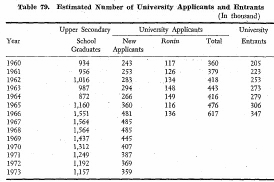| Home > Policy > White Paper, Notice, Announcement > White Paper > EDUCATIONAL STANDARDS IN JAPAN 1965 > CHAPTER |
||
The basis of the population entering higher education institutions is the number of upper secondary school graduates, which will show a remarkable increase in 1966, remain fairly constant until 1969, and then gradually decrease.

The percentage of upper secondary school graduates applying for admission to higher institutions has been increasing year by year, and it is expected that the number of applicants will continue to increase from now on, due to the improvement of living standards and increase of social demand for university graduates. Accordingly, in 1966, the number of applicants to university, including new graduates from upper secondary schools and so-called Ronin (students who have failed once or more to be admitted to higher education institutions and are studying in preparation for another entrance examination) together, is expected to be over 600,000. It is necessary to increase the admission capacity of universities to meet such a sudden increase of applicants. In 1966, the university places for new students are planned to increase to 350,000. By this means, the ratio of university entrants to the corresponding age group will remain 15 percent, whic1? is almost the same as that of 1963. It is urgently required toset Lip a long-term educational plan on higher education in prospect of the future demand, as it is foreseen that the population requiring higher education will increase greatly.
Considering the fact that the compulsory school population will tend to decrease in the future, the emphasis of educational policies now can be shifted from quantitative expansion to qualitative enrichment. As the upper secondary population will also decrease, although the ratio of entrants to upper secondary school will rise, the same policy as that for compulsory education can be adopted here, too. With the rise of the rate of entrants to upper secondary schools, and the diversification in terms of pupil abilities and interests, the following problems will inevitably arise for future consideration: how to receive such pupils and how education for the upper secondary school age group including educational institution other than regular schools, should be organized, in order to provide upper secondary education for all. As for the higher education, the social demand for university graduates and individual desires to receive higher education will increase more and more. With the increasing population receiving higher education, how to maintain and advance the quality of academic studies which is one of the missions of higher educational institutions will be of vital importance.
| Back to Top | MEXT HOME |